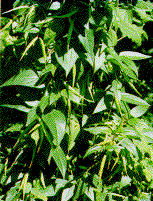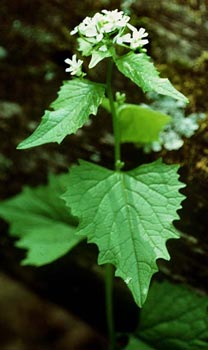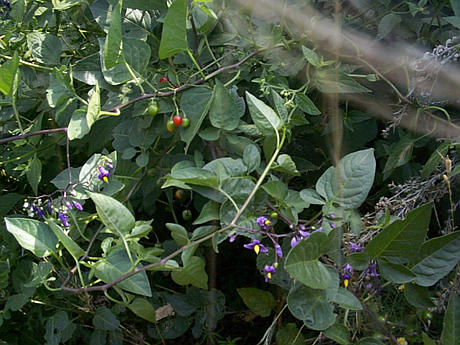
Invasive Plants of the Forest
Invasive plants are plants which are not native to a region. They have been brought over to Canada by mistake in grain or other shipments or have escaped from flower gardens to the forest. Many of these plants have no enemies in this country and thus grow fast and either shade out or push out many native species of trees, shrubs or flowering plants. There are a number of invasive plants in Altona Forest.
| Buckthorn (Rhamnus cathartica) |  |
We recently implemented a test plot for buckthorn management. Click here for details.
This tree is a native to Europe. It is considered an intrusive tree which grows quickly shading out native species of trees, shrubs and wild flowers. It often grows after a disturbance to a forested area. Many small areas of Altona Forest were cut down years ago making a suitable area for buckthorn. This tree has spread from these initial location to other areas were it competes and sometimes shades out the native species of trees, shrubs and flowering plants. Because of this, buckthorn is a common tree in Altona Forest. The elliptical to oval shaped leaves are either alternate or opposite, smooth, dark shiny green on the top, lighter green underneath. It has tiny thorns located on the stems, thus the name. Click here to view more images of the Buckthorn.
- Spring: the flowers are green to yellowish and appear in dense clusters during early June
- Summer: the purplish to black berry fruit develops during the summer ripens in August to September
- Autumn: the bitter tasting fruit is usually ignored by birds and other animals
- Winter: the birds will eat the fruit when there is nothing else available; birds spread the seeds over a wide area; the seeds germinate quickly the next spring and may grow half a metre in its first year
Buckthorns can even adversly affect birds. Biologists studying American Robins and Wood Thrushes in an urban reserve in Illinios, USA found that nest success was lower when located in exotic honeysuckle and buckthorn shrubs than when built in native trees and shrubs.
The Buckthorn is considered the most invasive species within the Altona Forest.
| Dog-strangling Vine (Cynanchum nigrum) |  |  |  |
 |  |
This plant, also called Black Swallowwort, is a herbaceous twining perennial of Eurasian origin. It is found in many areas in Altona Forest. It is in the milkweed family. It is commonly found near the fence line where the native plants have been disturbed. It is also found in some areas near the path. It is well named as thickets of this plant can entangle medium sized animals such as dogs. It becomes particularly thick like a low mat in September and early October.
Dog-strangling vine is a perennial which often grows along the ground and elevates itself to a height of .5 to 1.5 m or it will use trees, other plants and fences to climb. It has 5 lobed purple flowers, stems which are strong and flexible and opposite simple lilac-like leaves.
| Purple
Loosestrife (Lythrum salicaria L.) |  |
Purple loosestrife is a perennial wetland herb. It was introduced from Europe, probably by accident, in the 1800s. Because it has no natural enemies here, it has spread aggressively and is now widely found in meadows, river flood-plains, and damp roadsides throughout most of Ontario and the rest of North America. In Altona Forest, it is found along some trails and in and around the wetland.
The root system chokes out native plants and eventually this weed fills in ponds and marshes. It does not provide food or shelter for our wildlife but crowds out those plants which do provide these necessary things and so where it invades, valuable wildlife habitat is destroyed.
There seems to be no natural enemy of purple loosestrife in Canada. Five insects from Europe could potentially provide long-term control without harming native flora or fauna. Leaf-eating beetle adults and larvae as well as root mining weevil larvae are now being studied for their possible use against this most intrusive plant. The University of Guelph is testing a natural insect enemy of the loosestrife. This insect, the Galerucella beetle, larvae and adult, live exclusively on a diet of loosestrife. It is being sold in Ontario to conservation authorities, cottage owners and some businesses.
This perennial weed reproduces by seeds. The stems are from 60 -120 cm high, with branches and fine hairs. The stem is more or less square in cross-section which resembles the Mint family. This shape can be felt if the stem is rolled between the thumb and finger. The leaves are opposite or sometimes whorled (3 or more per node), stalkless, broad near the base and tapering towards the tip.
The 6-petaled flowers are seen in dense very showy terminal spikes made up of red-purple petals 7 - 10 mm long. It flowers from June to autumn. A single plant can produce three thousand individual flowers. Purple Loosestrife reproduces prolifically by cuttings and offshoots as well as by seeds. A single plant may produce up to 300,000 seeds, which are carried by wind, water and animals, which explains how it spreads so quickly.
Shakespeare called purple loosestrife "long purples" and "dead men's fingers."
| Garlic Mustard (Alliaria petiolata) |  |
Garlic mustard is a cool-season biennial herb that ranges from 12 to 48 inches in height as an adult flowering plant. Leaves and stems emit the distinctive odor of onion or garlic when crushed (particularly in spring and early summer), and help distinguish the plant from all other woodland mustard plants. First year plants consist of a cluster of 3 or 4 round, scallop edged leaves rising 2 to 4 inches in a rosette. Second-year plants generally produce one or two flowering stems with numerous white flowers that have four separate petals. Garlic mustard is the only plant of this height in our woods with white flowers in May. Fruits are slender capsules 1 to 2.5 inches long that produce a single row of oblong black seeds with ridged seed coats. Stem leaves are alternate and triangular in shape, have large teeth, and can be 2 to 3 inches across in fruiting plants. Petioles are longer on the leaves towards the base. Garlic mustard can also be distinguished by its uproot, which is slender, white, and "s"-shaped at the top of the root. Picture of Garlic Mustard Garlic Mustard
Garlic mustard is an exotic species introduced from Europe presumably by early settlers for its supposed medicinal properties and for use in cooking. It is widely distributed throughout the northeastern and Midwestern U.S. from Canada to South Carolina and west to Kansas, North Dakota, and as far as Colorado and Utah. It is shade-tolerant, and generally requires some shade; it is not commonly found in sunny habitats. It cannot tolerate acidic soils. The invasion of forests usually begins along the wood's edge, and progresses via streams, campgrounds, and trails.
This species is a biennial that produces hundreds of seeds per plant. The seeds are believed to be dispersed on the fur of large animals such as deer, horses, and squirrels, by flowing water and by human activities. In our areas, seeds lie dormant for 20 months prior to germination, and may remain viable for five years. Seeds germinate in early April. First-year plants appear as basal rosettes in the summer season. First-year plants remain green through the following winter, making it possible to check for the presence of this plant in your woods throughout the year. Garlic mustard begins vegetative growth early in the spring, and blooms from May through early June. Fruits begin to ripen in mid-July, and are disseminated through August. Viable seeds are produced within days of initial flowering.
| Bittersweet Nightshade (Solanum Dulcamara L.) |  |
Bittersweet Nightshade is a semi-woody vine rarely more than half an inch thick, yet capable of clambering 30 feet or higher into trees. Introduced from the Old World, it is now abundant here in many habitats, preferring moist, wild places. It is a troublesome weeds. Its foliage stinks like that of elderberry bushes. Beginning mid- to late May, 1/3 to 1/2 inch purplish (occasionally white) flowers with yellow centers, bloom, gradually changing into green, then yellow, next orange, finally bright red berries. A very rare sport has berries that stay orange even in decay, never developing the slightest red. When fully ripe the berries are harmless, not deadly. The leaves are 1 to 3 inches long and often bear lobes near their bases. After autumn and frost yellows the leaves, they drop, bidding goodbye to the colorful clusters of egg-shaped, translucent, juicy berries hanging on the bare, withered stems.
Dogs can be poisoned if they eat this stinking noxious pest. It is not all bad, however: in herbal medicine one use of the plant is for eczema. Some other names are: Woody or Climbing Bightshade, Tether Devil, Felonwood, Felonwort, Blue Bindweed, Snake's Poison Food, Poison Flower, Scarlet Berry, Snake Berry. Note the omission of "Deadly Nightshade," despite the fact that a large number of people so call this plant. (The original Deadly Nightshade, Atropa Belladonna, is happily extremely rare in comparison. It truly lives up to its ominous names: Death's Herb; Dwale; Belladonna; Naughty Man's Cherries.